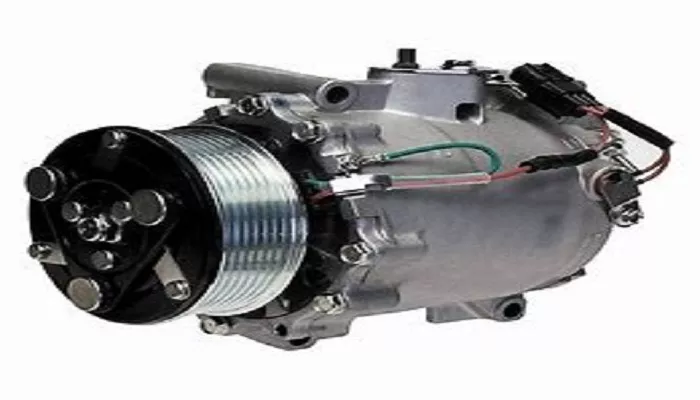The air conditioning (AC) compressor is a critical component in your Honda’s climate control system. It plays a vital role in circulating refrigerant and maintaining cool air inside the cabin. Like all mechanical parts, AC compressors have a finite lifespan, and their longevity depends on multiple factors, including maintenance, driving conditions, and overall system health.
Understanding the Honda AC Compressor
Before discussing lifespan, it’s essential to understand the function and design of an AC compressor in a Honda vehicle.
What Does an AC Compressor Do?
- Compressing refrigerant gas (usually R134a or R1234yf) to increase its pressure and temperature.
- Circulating refrigerant through the AC system to facilitate heat exchange.
- Maintaining proper cooling performance by ensuring refrigerant flow.
Types of Honda AC Compressors
Piston-Type Compressors: Common in older models, durable but prone to wear over time.
Scroll-Type Compressors: Found in newer models, more efficient with fewer moving parts.
Variable Displacement Compressors: Adjusts output based on cooling demand, improving efficiency.
Each type has a different wear pattern, affecting overall longevity.
Average Lifespan of a Honda AC Compressor
General Lifespan Expectations
Under normal conditions, a well-maintained Honda AC compressor can last
- 8 to 12 years (or 100,000 to 150,000 miles).
- Some compressors may fail earlier (around 60,000 miles) due to poor maintenance or manufacturing defects.
- In rare cases, they can exceed 15 years if the system is properly cared for.
Factors Affecting Lifespan
Maintenance & Refrigerant Levels
- Low refrigerant causes the compressor to overwork, leading to premature failure.
- Contaminated refrigerant or oil increases internal wear.
- Leaks in the system introduce moisture, damaging internal components.
Driving Conditions
- Frequent short trips prevent proper lubrication, increasing wear.
- Extreme heat or cold strains the compressor.
- Stop-and-go traffic forces the compressor to cycle more often.
Quality of Parts & Installation
- OEM (Original Equipment Manufacturer) compressors last longer than aftermarket ones.
- Improper installation (incorrect belt tension, refrigerant charge) can shorten lifespan.
Electrical & Belt System Health
- Failing clutch or relay causes intermittent operation, damaging the compressor.
- Worn serpentine belts slip, reducing efficiency.
Signs of a Failing Honda AC Compressor
Recognizing early symptoms of compressor failure can prevent costly repairs. Common warning signs include:
Reduced Cooling Performance
- Weak or warm airflow despite proper refrigerant levels.
- Inconsistent cooling (works sometimes, then stops).
Unusual Noises
- Grinding or squealing:Indicates bearing failure or lack of lubrication.
- Clicking when AC is turned on:Suggests a failing clutch.
- Knocking or rattling:Possible internal damage.
Leaking Refrigerant or Oil
- Oil stains near the compressor (usually green or black).
- Refrigerant leaks (hissing sound when AC is running).
AC Clutch Not Engaging
- The compressor clutch should spin when AC is on; if it doesn’t, the compressor may be seized.
Burning Smell
- Overheating compressor or electrical failure can produce a burnt odor.
How to Extend the Life of Your Honda AC Compressor
Regular AC System Maintenance
- Recharge refrigerant every 2-3 years (or when cooling weakens).
- Inspect for leaks and repair them promptly.
- Replace the cabin air filter to reduce strain on the system.
Use the AC Regularly
- Running the AC at least 10-15 minutes weekly keeps seals lubricated.
- Prevents refrigerant leaks due to dried-out O-rings.
Avoid Overuse in Extreme Conditions
- In very hot weather, use recirculation mode to reduce compressor load.
- Park in the shade to minimize initial cooling demand.
Address Electrical Issues Promptly
- Replace faulty relays, fuses, or switches to prevent compressor damage.
- Ensure proper belt tension to avoid slippage.
Use High-Quality Refrigerant & Oil
- Always use Honda-approved refrigerant (R134a or R1234yf).
- Avoid cheap recharge kits that may contain contaminants.
When to Replace a Honda AC Compressor
Repair vs. Replacement Considerations
- Minor issues (clutch failure, relay problems) can often be repaired.
- Major internal damage (seized pistons, broken valves) requires full replacement.
Cost of Replacement
- OEM Honda compressor: 400−1,000 (part only).
- Aftermarket compressor:200−600 (varies by quality).
- Labor costs: 300−800 (depending on complexity).
Should You Replace Other Components?
When replacing the compressor, it’s advisable to also replace
- Receiver-drier or accumulator (to prevent contamination).
- Expansion valve or orifice tube (ensures proper refrigerant flow).
- O-rings and seals (prevents future leaks).
Conclusion
A Honda AC compressor typically lasts 8 to 12 years (or 100,000 to 150,000 miles) under normal conditions. However, factors like maintenance, driving habits, and environmental conditions significantly impact its lifespan.

